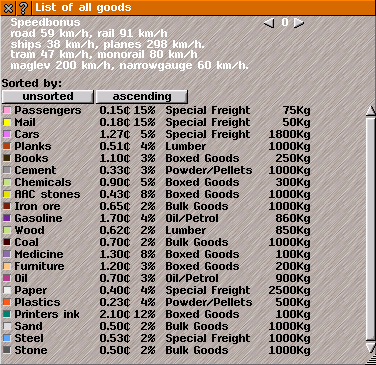Goods List Help
Goods List
The Goods list window contains information on the different items that can be transported in the game, and has tools for calculating the revenue generated by transporting passengers, mail and goods under particular conditions.
Items are listd in a table containing, with information about the revenue per unit, category, weight, and other matters about the items (see below for details).
Tip: If items in list are only partially visible, then
re-size the window or scroll the list using the slider bar.
At the top of the window are controls for adjusting various conditions that affect revenue.
Distance: Adjusting this setting (which is measured in kilometres: see the
map to check how many tiles to a kilometre: this is variable depending on the pakset) adjusts the distance over which the revenue per unit is calculated. As well as the revenue increasing with distance, adjusting the distance affects the extent to which comfort affects the revenue.
Comfort: Adjusting this setting shows the revenue for different
comfort levels. This setting only affects passengers. Comfort has a greater effect at higher distances.
Speed: Adjusting this setting alters the assumed average speed for the journey. Together with the distance, this is used to calculate a journey time, which is then used to calculate how comfort and catering affects revenue. Generally, comfort and catering have a greater effect the longer that a journey lasts.
Catering level: Adjusting this setting alters the level of catering assumed for the journey. This affects the revenue of passengers. A catering level of 1 for mail means that the mail is being transported with a travelling post office, which increases revenue.
Class: Adjusting this setting shows the revenue for different classes of passengers and mail. Higher classes of mail and passengers are able to pay more for their journeys than lower classes, but will often ride in lower class accommodation (and therefore pay a lower class fare) unless they can obtain any increase in speed (or, in the case of passengers, a significant increase in comfort) by travelling in higher class accommodation.
Sorted by: has options to determine the order of items shown in the list.
Click the option buttons to cycle through options (changes name of the option button):
- unsorted no particular order;
- by name alphabetical order by name;
- by weight numerical order by weight;
- by category alphabetical order by the category; and
- by revenue numerical order by income received for transport of one unit by the number of tiles selected in "distance".
- ascending / descending reverses the order of the list.
Details listed for each item include:
Colour is the same colour displayed in bar chart shown in the main game window above a
stops to the indicate quantity of items of that type waiting for transport.
Tip: Use [!] to toggle the goods colour bars above a Stop in the main game window.
Revenue is the income received for transporting one of this item by the number of kilometres selected above under "distance".
Tip: when deciding which items are the most profitable to carry, considering only the revenue per unit can be misleading, as far larger quantities of some sorts of units can be carried in vehicles than others.
Category is the category to which each item belongs. With the exception of the
special freight category, all types of items can be transported in any vehicle designed for any other type of item of that same category: for example, in most paksets, both coal and iron ore can be transported in the same types of vehicles, as both types of item belong to the "bulk" category.
Tip: The
capacity of vehicles shows the category that a vehicle can transport. Each vehicle can only transport items of one category, and cannot transport multiple types of items of the same category at one time. However, convoys can contain vehicles of different categories and carrying different types at the same time.
Weight is the weight of each item in kilogrammes. This weight is multiplied by the number of items carried on a vehicle and added to the vehicle's total weight, which can reduce the speed at which it travels or accelerates, as well as whether it can pass over a given bridge.
Tip: When checking to see whether a vehicle does not exceed the weight limit for any part of its route, make sure to take into account the weight of the items carried,

